Dental Implant
Today I had the opportunity of a lifetime. None of my colleagues or even majority of other dentists at this age have had this opportunity to be a 'junior dentist' and assist in an implant case.
We had an implantologist coming in from Saudi Arabia to do 2 implant patients in a single day and I took this opportunity to be his assistant in these cases. This dentist has done his masters from the UK and now is working as a full time dentist in Saudi Arabia.
The two patients on whom implants were to be carried out on were not charged a single penny and we wanted to do this as charity work. An implant on average costs more than a couple of hundred of dollars here in Pakistan.
Implant is a multiple step procedure which takes over a period of 6 months to complete. This is because the bone in which we drill, needs to heal and it takes at least six months to heal. Within this time period a couple of things are done auch as drilling, inserting a cover screw, taking impressions, abutments etc. let's see how an implant is carried out:
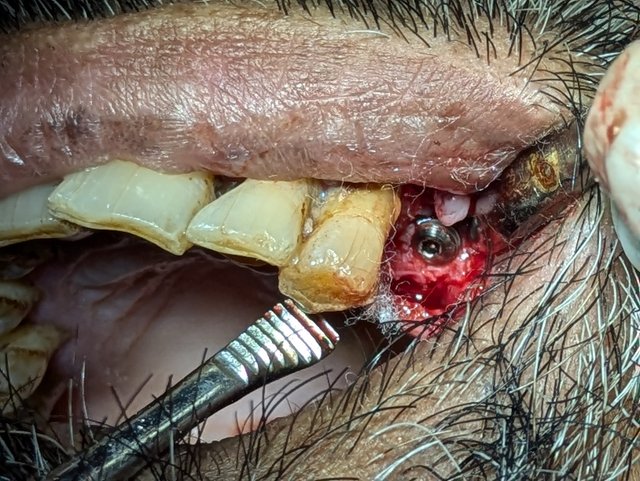
Before discussing the details of the procedure, let's discuss what a dental implant is. When you lose a tooth, especially during your prime years, there are several options for artificial teeth. You can choose either a removable prosthesis or a fixed prosthesis. Within fixed prosthetics, there are additional choices such as a dental bridge or an implant.
Each of these options comes with its own set of limitations. For instance, an implant is often considered the best option, but it is contraindicated for individuals with certain conditions, such as diabetes. Similarly, a fixed bridge can be an excellent choice, but it is not suitable for those with poor gum health, such as periodontitis. Therefore, a comprehensive evaluation of both the patient's systemic health and dental health is crucial when determining the most appropriate course of action.
Dental implants are artificial tooth roots that provide a permanent base for fixed, replacement teeth. Unlike dentures, bridges, and crowns, implants are a popular and effective long-term solution for people who suffer from missing teeth, failing teeth, or chronic dental problems. Because they fit, feel, and function like natural teeth, dental implants are quickly becoming the new standard in tooth replacement.
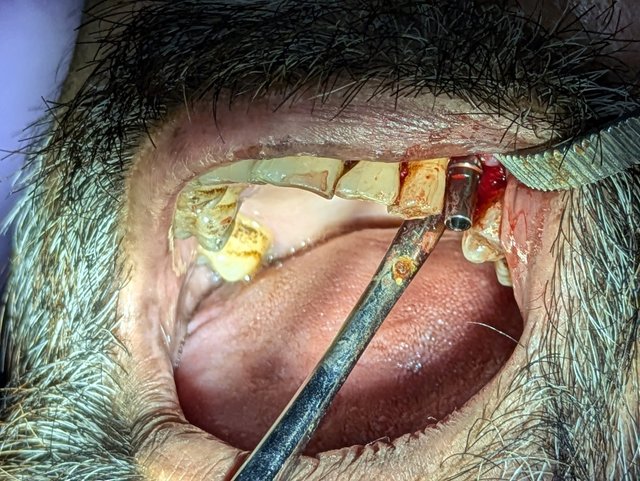
The initial step in placing a dental implant is to assess the oral condition and counsel the patient regarding the pros and cons of the implant. A preliminary Cone Beam Computed Tomography (CBCT) scan is essential. This scan provides detailed images of the patient's jawbone, allowing the dentist to evaluate its condition and determine if the implant will remain intact. The next step is to formulate a treatment plan, which includes deciding the type of implant the patient needs. The dentist will assess the bone density and determine the ideal width and length of the implant to ensure it fits securely and functions correctly.
Once all these preliminary steps have been completed and assessed by the dentist, the procedure begins with the administration of local anesthesia to numb the patient's oral cavity. If there is no existing tooth in the implant site, an incision is made in the gum to expose the underlying jawbone. This incision is then widened to allow better access and visibility. The next step involves drilling into the jawbone to create a space for the implant.
The drilling must be precise, ensuring that the implant will fit securely and be able to withstand the forces exerted during chewing. The implant, usually made of titanium, is then inserted into the drilled hole in the bone. This ensures that the implant is firmly fixed and provides a stable foundation for the abutment and crown that will be attached later. Proper placement is crucial for the success of the implant, requiring skill and accuracy to avoid damaging surrounding structures. After the implant is placed, the gum tissue is stitched back into place, and the healing process begins, paving the way for the subsequent steps of osseointegration and abutment placement.
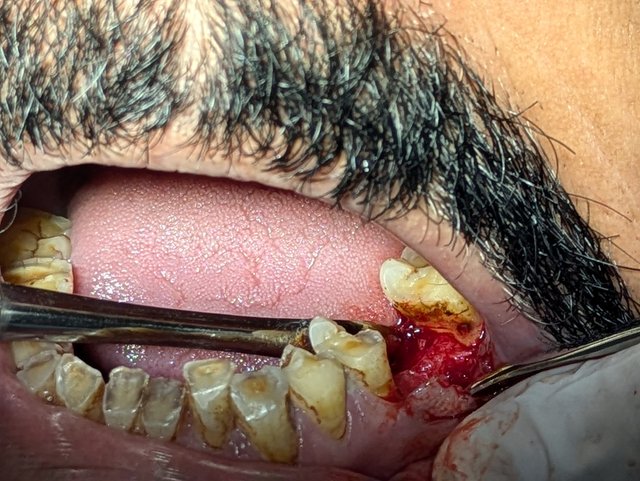
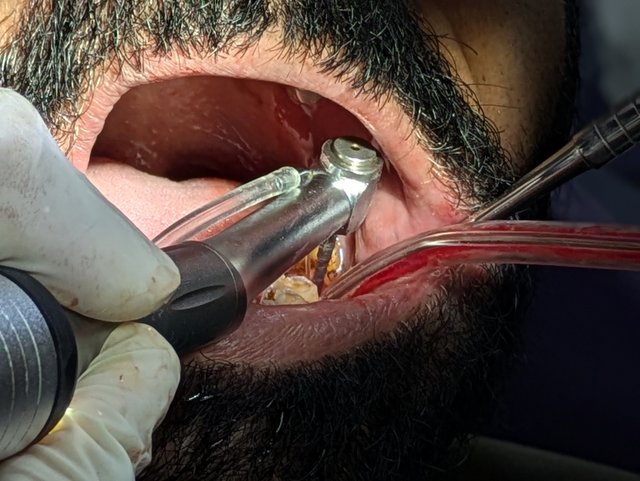
After the implant has been placed, the surgical site is sutured closed, and a healing period of at least three months is required. During this time, osseointegration occurs. This crucial process involves the implant fusing firmly with the jawbone, ensuring the implant's strength and stable fixation. This period is vital for the long-term success of the dental implant as it creates a solid foundation for the subsequent stages.
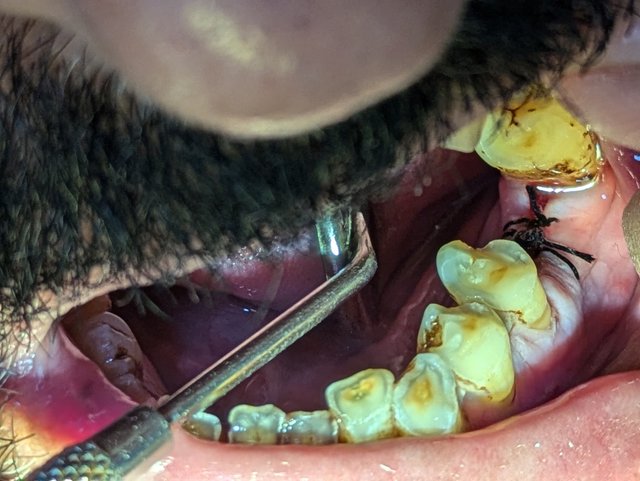
Once the healing period has passed, the patient returns for the next phase of the treatment. During this visit, an abutment is attached to the implant. The abutment acts as a connector between the implant and the final prosthetic crown. It protrudes slightly above the gumline, allowing for the attachment of the crown after the gum tissue heals around it.
Consider yourself fortunate while reading this, as you're getting complete information along with pictures. Today, we had two patients at different stages of the dental implant process. The first patient was in the initial steps, where we placed the implant and sent him back home to allow for healing and osseointegration, as seen above. The second patient returned after four months to have his abutment fixed. This follow-up visit was crucial to attach the abutment securely to the implant that had successfully integrated with the jawbone. You'll see detailed photographs of the second patient below.
Assessing the second patient, after ensuring that osseointegration had occurred successfully, we reopened the gum tissue to expose the implant. The abutment was then attached securely to the implant, and a healing cap was placed over it to protect the site as the gum tissue healed around the abutment.
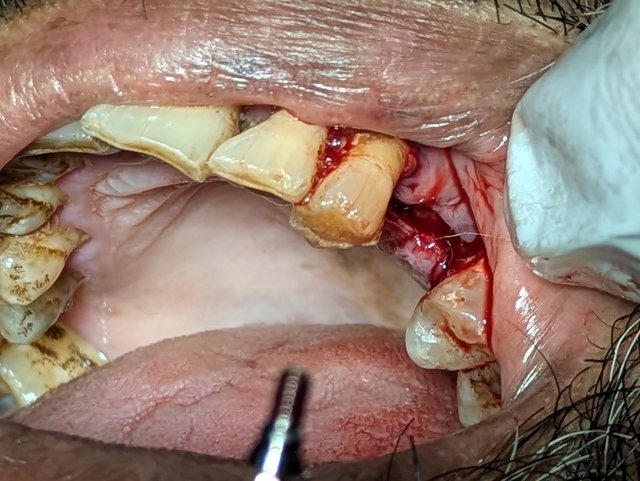

After the gum has healed around the abutment, the final step is to attach the crown, which is the artificial tooth. Impressions of your mouth are taken to create a custom crown that matches the color, shape, and size of your natural teeth. The crown is then fabricated in a dental laboratory and securely attached to the abutment. Healing is absolutely essential in implant cases and that's the reason why these procedures span over a period of 6 months. After the abutment placement, the patient is asked to revisit after 4-6 weeks once healing is done.
I'll update you guys when we call these patients for crown placement. If you liked this article do let me know in the comments section.
Thank you
So, for those who have gold tooth, Is this the same procedure they go through or is something they fixed??
During that 4 months period while they are away for healing… will they eat any solid food because i can’t imagine how painful it will be for the patient when the Anesthesia fades away..
One last question, those black stains inside the teeth of the patient, how can it be cleaned because it seems toothpaste can’t do it alone..
0.00 SBD,
0.07 STEEM,
0.07 SP,
0.00 TRX
Can be either. A gold implant or a bridge.
It depends upon patient to patient. It does hurt in the starting period but once the implant starts fusing with the bone, the pain significantly decreases.
In this particular patient, there are a lot of things that needs treatment. For example you can see that his teeth look 'chipped off', that's attrition. He's got abrasion as well. Root caries can also be seen and gum recession is also dominant. So he needs a complete makeover but talking about stains, extrinsic stains can be removed through unltrasonic scaling to an extent but for intrinsic stains, whitening procedure needs to be done where we apply carbamide peroxide and hydrogen peroxide.
0.00 SBD,
0.02 STEEM,
0.02 SP,
0.00 TRX
Thank you very much for the information you share with us about our dentals… I am really learning
Thank you @event-horizon :')